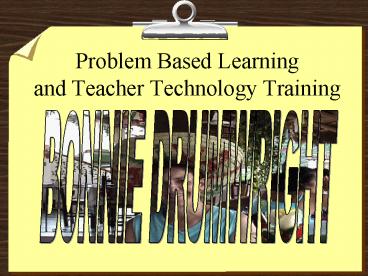Problem Based Learning and Teacher Technology Training - PowerPoint PPT Presentation
1 / 25
Title:
Problem Based Learning and Teacher Technology Training
Description:
Teachers are not effectively using the computer for web-based ... http://www.ctap2.bcoe.butte.k12.ca.us/score/index.html. http://www.bham.wednet.edu/quest.htm ... – PowerPoint PPT presentation
Number of Views:125
Avg rating:3.0/5.0
Title: Problem Based Learning and Teacher Technology Training
1
Problem Based Learningand Teacher Technology
Training
BONNIE DRUMWRIGHT
2
Problem Based Learningand Teacher Technology
Training
KATHRYN ODELL
3
Problem Based Learningand Teacher Technology
Training
JAN VALINE
4
The Problem
- Teachers are not effectively using the computer
for web-based activities in the classroom.
5
Many teachers dont know how to
- Create activities for their students involving
the Internet - Use WebQuests
- Use software to create web pages
- Create technology projects
- with educational objectives
6
Causes of the Problem (Shelton, 1996)
- Perceived inadequacies in training
- Lack of time for preparation
- Limited access to computer hardware/software
- Lack of support
7
Additional Cause
- Resistance to change
- According to Becker, (1999) teachers need to be
convinced of the value of engaging students in
PBL.
8
The AnswerTechnology Training for Teachers
- The Four Ts (Shelton Jones, 1996)
- Time
- Training
- Technology (hardware software)
- Teacher-type tasks
9
The Answer (Part 2)
- Problem Based Learning
- The strategy explained
- Problem-Based Learning (PBL) is an instructional
strategy that promotes active learning. (Samford
University, 2000) - PBL is any learning environment in which the
problem drives the learning. That is, before
students learn some knowledge they are given a
problem. The problem is posed so that the
students discover that they need to learn some
new knowledge before they can solve the problem.
(Woods, 1996)
10
Characteristics of PBL
- Learning is student centered.
- Learning occurs in small groups.
- Teachers are facilitators or guides.
- Problems form the organizing focus and stimulus
for learning. - Problems are a vehicle for the development of
clinical problem-solving skills. - New information is acquired through self-directed
learning.
11
Process of PBL
Confront a problem.
Organize what Is known and identify the nature
of the problem.
Pose questions.
Design a plan
Gather information.
Solve the problem.
That solves the problem
That identifies needed resources.
12
Outcomes of PBL
- Ability to find and use appropriate resources
- Problem-solving skills
- Self-directed learning skills
- Critical thinking
- Facility with computer
- Ability to work on a team
- Communication skills
13
Problem-Based Learning causes a shift in roles
(imsa.edu, 2001)
14
At PBLs organizing center is The Ill-Structured
Problem
- Complex in nature
- Requires inquiry, information-gathering, and
reflection - Is changing and tentative
- Has no simple, fixed, right solution
15
Our Study
- Research Problem Teachers are not effectively
using technology in the classroom. - Research Questions
- What impact will instruction in website creation
have upon teacher utilization of technology in
the classroom? - What is the effect of instruction in website
creation using a PBL training strategy? - How does the use of Dreamweaver software effect
teacher utilization of technology in the
classroom?
16
Our Study
- Purpose of the study To explore whether
providing teachers with a simple format of
training to create a class website will impact
upon their utilization of technology in the
classroom.
17
Procedure
- General population Classroom teachers employed
by SCOE, Grades K-8 - Sample Volunteer teachers employed by SCOE,
Grades K-8 - Survey Administer pre- and post-surveys to the
subjects.
18
The Survey
- A Likert scale questionnaire
- Assesses teacher attitudes towards technology
- Assesses teacher confidence in technology in
general, and web design, specifically
19
The Treatment
- Three 3 hour sessions on web page design
- Teaching strategies
- Problem Based Learning
- Mini-lectures
- Demonstrations, modeling
- Online tutorials
20
The Treatment (continued)
- The simulation
- A letter from the Technology Director
- Participants in grade-level groups
- The assignment to create a web page template to
be used by classroom teachers at a specific grade
level.
21
Findings
- Participants will demonstrate improvement in
computer skills and confidence after the
treatment. - After a follow-up period, there will be an
increase in the use of the computer for web-based
activities.
22
Links
- Problem-based learning
- http//www.samford.edu/pbl.what.html
- http//www.imsa.edu/team/cpbl/whatis.html
- http//www.cotf.edu.ete.teacher.tprob/teacherout.h
tml - http//www.cusd.chico.k12.ca.us/pmilbury/collab.h
tml - http//www/rims.k12.ca.us/score/
- http//www.edserv.sjcoe.k12.ca.us/score/index.html
- http//www.ctap2.bcoe.butte.k12.ca.us/score/index.
html - http//www.bham.wednet.edu/quest.htm
23
More Links
- Dreamweaver tutorial and templates
- http//www.taskstream.com/Main/login/default.asp
- Http//www.trainingcafe.com/members/coursesite
- WebQuest Page
- http//edweb.sdsu.edu/webquest/webquest.html
24
Suggestions for future research
- What would be the effect of using the PBL
strategy along with the spreadsheet or database
tool in teacher technology training? - Would there be a difference in effectiveness when
comparing elementary-school vs. high school
teachers using the approach in this study?
25
Problem Based Learning
- Lets try it!

